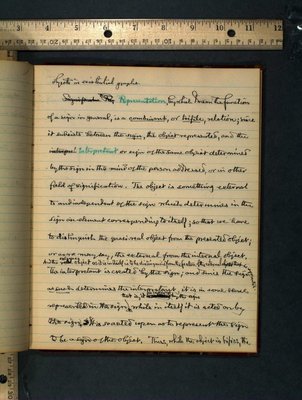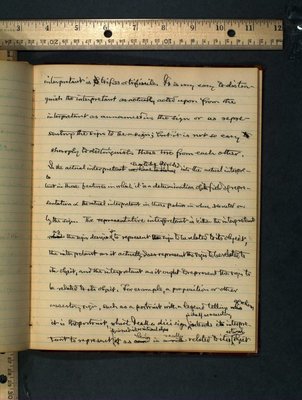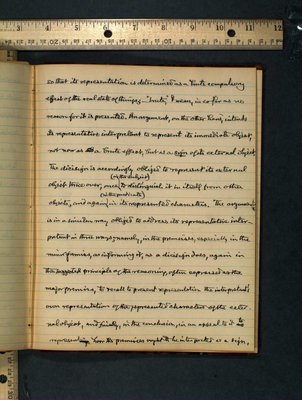Pages
28
Objects in existential graphs
Representation, [??] the function of a sign in general, is a combinant, or trifile, relation; since it subsists between the origin, the object represented, and the interpretant or sign of the same object determined by the sign in the mind of the person addressed, or in other field of signification. The object is something external to and independent of the sign which determines in the sign on element corresponding to itself; so that we have to distinguish the quasi real object from the presented object; or as we may say, the external from the internal object, And the [?] object as it is itself is to be distinguished from the feature the external object that is presented. The interpretant is created by the sign; and since the sign as such dtermines the interpretent, it is some sense represented in the sign that is [??] while in itself it is acted on by the sign. It is [??] upon as to represent the sign to be a sign of the object. Thus, while the object is [?], the
29
interpretant is trefiss or trefissile. It is very easy to distinguish the interpretant as actually acted upon from the interpretant as ammounted in the sign or as representing the sign to be a sign; but it is not so easy sharply to distinguish these two from each other. In the actual interpretant [??] be divided into the actual interpretant in thse features in which it is a determination of its field of representation or the actual interpretant in those features in where [??] on by the sign. The representative interpretant is either the interpretant as the sign designs it to represent the sign to be related to its object, the interpretant as it actually does represent the sign to be related to its object, and the interpretant as it ought to be present this sign to be related to its object. For example, a proposition or other assentory? sign, such as a portrait with a legend telling of when it is the portrait, whichthather dici sign in itself [??] intends its interpretant to represent it in its [??] as being in really related to its external object
30
so that its representation as a brute compulsorry effect of the [?] state of things; - "brute," I mean, in so far as no reason for it is presented. An argument, on the other hand, intends its representative interprelant to represents its immediate object, not now as a brute effect, but as a sign of its external object. The dicisign is accordingly obliged to represent its external object twice over, once to distinguish it in itself from other objects, and again (in the predicate) in its represented characters. The argument isin a similar way obliged to address it's representative interpretant in three ways, namely, in the premises, especially in the minor premis, as informing it, as a dicifign does, again in the suggested principle of the reasoning, often expressed as the major premis, to recall to present representation the interpretants own representation of the represented charaters of the external object, and finally, in the condension, in an appeal to it to represent how the premises ought to be in the [??] as a sign,




